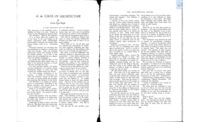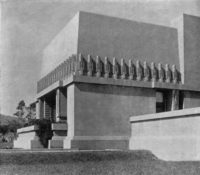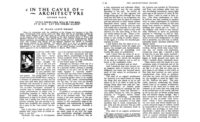From Architectural Record, June, 1927. Read a PDF of the original article here.
John Ruskin and William turned away from the machine and all it represented in modern art and craft. They saw the deadly threat it was to all they loved as such – and eventually turned again to fight it, to the death – their death. They are memories now. Pleasant ones. They did not succeed in delaying destruction nor in constructing anything. They did, however, remind us of what we were losing by using the machine or, as they might have said, letting the machine use us.
Repetition carried beyond a certain point has always taken the life of anything addressed to the living spirit.
Monotony kills.
Human feeling loves the vigor of spontaneity, freshness, and the charm of the unexpected. In other words, it loves life and dreads death.
The Machine Ruskin and Morris believed to be the enemy of all life. It was and is so still, but only because the artist has shirked it as a tool while he damned it; until now he has been damned by it.
Standardization as a principle is at work in all things with greater activity than ever before.
It is the most basic element in civilization. To a degree it is civilization itself.
An oriental rug, lustrous, rich with color and light, gleaming with all the brilliant pattern opulent oriental imagination conceived, has a very definite basis of standardization in warp and woof. In the methodical stiches regularly taken with strands of woolen yarn, upon that regular basis of cotton strings, stretched tight, lies the primitive principle of standardization. Serving the imagination full well.
Standardization here serves the spirit well – its mechanics disappear in the glowing fabric of the mind – the poetic feeling of the artist weaver with love of beauty in his soul.
Standardizationshould have the same place in the fabric we are weaving which we call civilization – as it has in that more simple fabrication of the carpet. And the creative artist-mind must put it into the larger more comprehensive fabric.
How?
Not so simple.
This principle of standardization has now as its tool or body – the Machine. An ideal tool compared to which all that has gone before is as nothing.
Probably Gutenberg’s invention of movable types was the first great advent of the machine in any sweeping form.
The blessing of that invention is obvious as is the curse that came with it.
The body of the book became volatile, almost infinite – and mind failed to keep up with it. Trash inundated the civilized world and streams of printed pages became wrapping paper to fill packing cases, light fires and blow unheeded about the gutters of the world.
A deluge. And yet the book lives. There are a thousand writers for one in earlier eras and mostly worth one-thousandth part as much. “Shifting type” was the principle of standardization at work. The machine is the “press,” that we have to-day serving it. What happened here in printing has happened to nearly everything in our lives. Happened or is happening or soon to happen with similar but more disastrous results; quantity at expense of quality – with always the blessing that comes from it, making available to the poor and needy a cheap or debased form of what was once rare and precious. I am speaking of fine art from the architect’s standpoint.
So we see in the Machine the forerunner and ideal agent of Usonian Democracy such as it is. A Democracy sentimental and unsound, but that is another and longer story.
We see in this old force a new agency hard to control. A force once released into the world – never to be stopped until every thing in it once precious and valuable for its own sake in its intimate relation to former good or great life has been fed to the dogs, or swine, speaking bitterly. But meantime raising the opportunities for “Having things” the world over with a chance of turning the dogs, or swine, into more human beings.
And, honestly let it be said, of putting all human beings perhaps at the mercy of swine and dogs.
This is where the creative artist steps in: to bring new life of the mind to this potent agency: new understanding that will make living more joyous and genuine by abolishing the makeshift, showing up imitation for the base thing it is – saving us from this inglorious rampage and rapine upon antiquity. There is no artist conscience, it seems, in all this. The artist is like a hungry orphan turned loose in a bake shop. The creative artist is not in it.
That ancient honor of the race, creative art, can not be dead. It needs only awakening. Now wonder it lies all but moribund floating in the “deluge” at the mercy of the current of ubiquity, rushing toward – well, let us hope, toward the great peace of the great ocean.
This principle of standardization then, is no detriment to art or artist. It has always existed. And like any principle has its uses and its abuses.
How foolish therefore to take a prevalent abuse of any thing for the thing itself?
An artist is sentient. He is never fooled by brains or science or economics. He knows by feeling –say instinct –right or living, from wrong or dead.
He may not, however, have the technique to make his “knowing” effective and so remain inarticulate. But it is his duty to know, for his technique is what makes him serviceable to his fellows as artist. Acquiring the technique of the Machine as the tool of standardization, mastering the nature of both, is the only thing now that will make him the living force necessary to salvage the flotsam and the jetsam of the “deluge,” or, let it all go and begin over again.
Begin another era: the modern era of the machine with all it implies, the economically making life more joyous and abundant as a matter of quality – as well as quantity.
Standardization apprehended as a principle of order has the danger of monotony in application.
Standardization can be murderer or beneficent factor as the life in the thing standardized is kept by imagination or destroyed by the lack of it.







